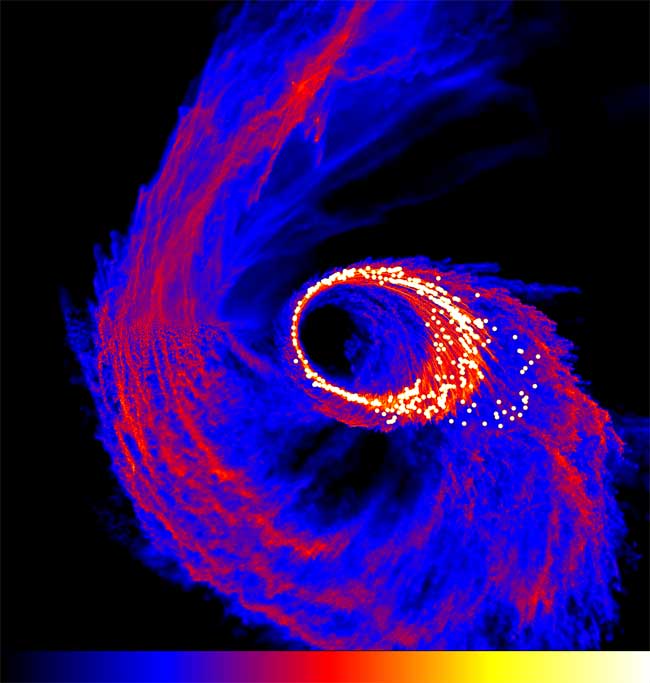'Dark Gulping' Could Explain Black Holes

No, it's not the next soft-drink campaign. "Darkgulping" is a new hypothesis about how giant black holes might have formedfrom collapsing dark matter.
Supermassive black holes are amystery. These behemoths can pack the mass of billions of suns, and oftenlurk in the centers of big galaxies likethe Milky Way. But scientists don't know how they got started nor how theygrew so massive.
A new computer model suggests dark gulping is one possibleroute to forming these monsters. The idea involves invisible dark matter, whichis stuff of unknown nature that astronomers know exists because they see itsgravitational effects on galaxies.
In this scenario, a large cloud of dark matter couldinteract with gas to form a dense central mass. Depending on how the darkmatter stores heat, this mass could be unstable. A small disturbance mightprompt the dark matter to collapse quickly, gulping itself down to create ablack hole. Though it would originallybe invisible, soon it would gobble down regular matter and gas and, withall that material swirling in and being superheated and luminous, becomevisible.
This hypothesis seems plausible, but there is no proof yetthat it ever happened, said Kinwah Wu, an astrophysicist at University CollegeLondon's Mullard Space Science Laboratory, who built the model with colleague CurtisSaxton.
"It?s a viable, possible scenario," Wu told SPACE.com."The model works, but it doesn't mean that nature behaves like that. Weneed more observational proof or disproof of this."
Saxton will present the findings this week at the EuropeanWeek of Astronomy and Space Science at the University of Hertfordshire inHatfield, England.
Breaking space news, the latest updates on rocket launches, skywatching events and more!
Black holes can't be seen because once light and matter getinside one, they are trapped. But on the way in, all the material creates achaotic mess of radiation that does escape into space. From observations of far-awayquasars ? bright objects thought to be anchored by black holes andsurrounded by intense star formation ? scientists think that supermassive blackholes existed when the universe was less than a billion years old. Yet mosttheories about these gigantors can't explain how they formed so early.
For example, many experts have suggested that supermassiveblack holes are the result of smaller black holes merging. But that processwould likely have taken too long to account for their appearance when theuniverse was so young.
Dark gulping is appealing because it would happen veryquickly, Wu said. Black holes born this way would simply be born huge, andwouldn't have to accrete the matter slowly over time.
Ongoing studies attempting to figure out what dark matter ismade of and how it is spread around the universe could help prove or disprovedark gulping.
- Video - Black Hole Warping Time & Space
- Vote Now: The Strangest Things in Space
- Images: Amazing Galaxies
Join our Space Forums to keep talking space on the latest missions, night sky and more! And if you have a news tip, correction or comment, let us know at: community@space.com.

Clara Moskowitz is a science and space writer who joined the Space.com team in 2008 and served as Assistant Managing Editor from 2011 to 2013. Clara has a bachelor's degree in astronomy and physics from Wesleyan University, and a graduate certificate in science writing from the University of California, Santa Cruz. She covers everything from astronomy to human spaceflight and once aced a NASTAR suborbital spaceflight training program for space missions. Clara is currently Associate Editor of Scientific American. To see her latest project is, follow Clara on Twitter.
